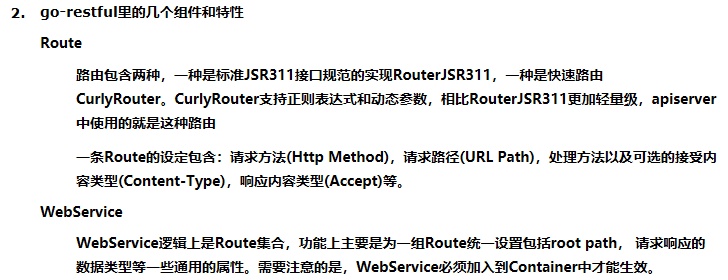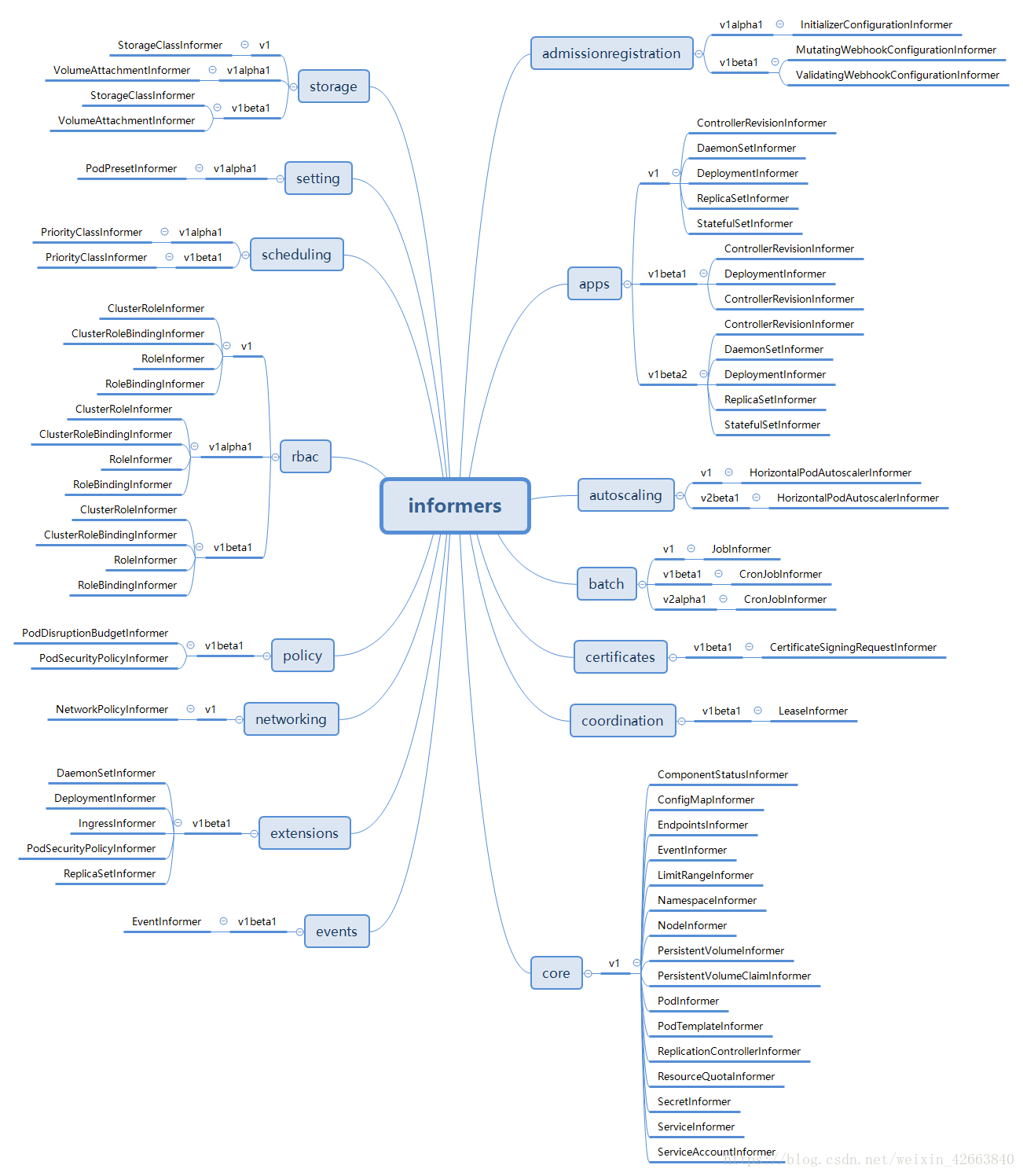1. 简介
apiserver使用go-restful来构建REST-style Web服务,所以我们先来了解一下这个包的相关内容,以便更好地理解apiserver的源码。



3. 创建http server步骤
- 创建Container。
- 创建自定义的Resource Handle,实现Resource相关的处理方法。
- 创建对应于Resource的WebService,在WebService中添加相应Route,并将WebService加入到Container中。
- 启动监听服务。
// APIServerHandlers holds the different http.Handlers used by the API server.
// This includes the full handler chain, the director (which chooses between gorestful and nonGoRestful,
// the gorestful handler (used for the API) which falls through to the nonGoRestful handler on unregistered paths,
// and the nonGoRestful handler (which can contain a fallthrough of its own)
// FullHandlerChain -> Director -> {GoRestfulContainer,NonGoRestfulMux} based on inspection of registered web services
type APIServerHandler struct {
// FullHandlerChain is the one that is eventually served with. It should include the full filter
// chain and then call the Director.
FullHandlerChain http.Handler
// The registered APIs. InstallAPIs uses this. Other servers probably shouldn't access this directly.
GoRestfulContainer *restful.Container
// NonGoRestfulMux is the final HTTP handler in the chain.
// It comes after all filters and the API handling
// This is where other servers can attach handler to various parts of the chain.
NonGoRestfulMux *mux.PathRecorderMux
// Director is here so that we can properly handle fall through and proxy cases.
// This looks a bit bonkers, but here's what's happening. We need to have /apis handling registered in gorestful in order to have
// swagger generated for compatibility. Doing that with `/apis` as a webservice, means that it forcibly 404s (no defaulting allowed)
// all requests which are not /apis or /apis/. We need those calls to fall through behind goresful for proper delegation. Trying to
// register for a pattern which includes everything behind it doesn't work because gorestful negotiates for verbs and content encoding
// and all those things go crazy when gorestful really just needs to pass through. In addition, openapi enforces unique verb constraints
// which we don't fit into and it still muddies up swagger. Trying to switch the webservices into a route doesn't work because the
// containing webservice faces all the same problems listed above.
// This leads to the crazy thing done here. Our mux does what we need, so we'll place it in front of gorestful. It will introspect to
// decide if the route is likely to be handled by goresful and route there if needed. Otherwise, it goes to PostGoRestful mux in
// order to handle "normal" paths and delegation. Hopefully no API consumers will ever have to deal with this level of detail. I think
// we should consider completely removing gorestful.
// Other servers should only use this opaquely to delegate to an API server.
Director http.Handler
}
3.1 创建 container
master.Config --> Complete() --->CompletedConfig ---> New()-->InstallAPIs --->InstallLegacyAPIGroup -> installAPIResource --> apiGroupVersion.InstallREST
container 容器为 : s.Handler.GoRestfulContainer
3.2 创建handler
s, err := c.GenericConfig.New("kube-apiserver", delegationTarget)
// New creates a new server which logically combines the handling chain with the passed server.
// name is used to differentiate for logging. The handler chain in particular can be difficult as it starts delgating.
// delegationTarget may not be nil.
func (c completedConfig) New(name string, delegationTarget DelegationTarget) (*GenericAPIServer, error) {
handlerChainBuilder := func(handler http.Handler) http.Handler {
return c.BuildHandlerChainFunc(handler, c.Config)
}
apiServerHandler := NewAPIServerHandler(name, c.Serializer, handlerChainBuilder, delegationTarget.UnprotectedHandler())
handlerChaninBuilderFn 用于包装gorestfulcontainer的处理器,提供处理链
// HandlerChainBuilderFn is used to wrap the GoRestfulContainer handler using the provided handler chain.
// It is normally used to apply filtering like authentication and authorization
type HandlerChainBuilderFn func(apiHandler http.Handler) http.Handler
func NewAPIServerHandler(name string, s runtime.NegotiatedSerializer, handlerChainBuilder HandlerChainBuilderFn, notFoundHandler http.Handler) *APIServerHandler {
nonGoRestfulMux := mux.NewPathRecorderMux(name)
if notFoundHandler != nil {
nonGoRestfulMux.NotFoundHandler(notFoundHandler)
}
gorestfulContainer := restful.NewContainer()
// ServeMux还负责清理URL请求路径,/重定向包含的任何请求。或者.。元素或重复的斜杠/作为等效的、更干净的URL。
gorestfulContainer.ServeMux = http.NewServeMux()
// 添加请求路径
gorestfulContainer.Router(restful.CurlyRouter{}) // e.g. for proxy/{kind}/{name}/{*}
gorestfulContainer.RecoverHandler(func(panicReason interface{}, httpWriter http.ResponseWriter) {
logStackOnRecover(s, panicReason, httpWriter)
})
gorestfulContainer.ServiceErrorHandler(func(serviceErr restful.ServiceError, request *restful.Request, response *restful.Response) {
serviceErrorHandler(s, serviceErr, request, response)
})
director := director{
name: name,
goRestfulContainer: gorestfulContainer,
nonGoRestfulMux: nonGoRestfulMux,
}
return &APIServerHandler{
FullHandlerChain: handlerChainBuilder(director),
GoRestfulContainer: gorestfulContainer,
NonGoRestfulMux: nonGoRestfulMux,
Director: director,
}
}
https://blog.csdn.net/Daniel_greenspan/article/details/78624725
3.3 WebService加入到Container中
apiResources, ws, registrationErrors := installer.Install()
// InstallREST registers the REST handlers (storage, watch, proxy and redirect) into a restful Container.
// It is expected that the provided path root prefix will serve all operations. Root MUST NOT end
// in a slash.
func (g *APIGroupVersion) InstallREST(container *restful.Container) error {
prefix := path.Join(g.Root, g.GroupVersion.Group, g.GroupVersion.Version)
installer := &APIInstaller{
group: g,
prefix: prefix,
minRequestTimeout: g.MinRequestTimeout,
enableAPIResponseCompression: g.EnableAPIResponseCompression,
}
apiResources, ws, registrationErrors := installer.Install()
versionDiscoveryHandler := discovery.NewAPIVersionHandler(g.Serializer, g.GroupVersion, staticLister{apiResources})
versionDiscoveryHandler.AddToWebService(ws)
container.Add(ws)
return utilerrors.NewAggregate(registrationErrors)
}
// Install handlers for API resources.
func (a *APIInstaller) Install() ([]metav1.APIResource, *restful.WebService, []error) {
var apiResources []metav1.APIResource
var errors []error
ws := a.newWebService()
// Register the paths in a deterministic (sorted) order to get a deterministic swagger spec.
paths := make([]string, len(a.group.Storage))
var i int = 0
for path := range a.group.Storage {
paths[i] = path
i++
}
sort.Strings(paths)
for _, path := range paths {
apiResource, err := a.registerResourceHandlers(path, a.group.Storage[path], ws)
if err != nil {
errors = append(errors, fmt.Errorf("error in registering resource: %s, %v", path, err))
}
if apiResource != nil {
apiResources = append(apiResources, *apiResource)
}
}
return apiResources, ws, errors
}

创建webservice
// newWebService creates a new restful webservice with the api installer's prefix and version.
func (a *APIInstaller) newWebService() *restful.WebService {
ws := new(restful.WebService)
ws.Path(a.prefix)
// a.prefix contains "prefix/group/version"
ws.Doc("API at " + a.prefix)
// Backwards compatibility, we accepted objects with empty content-type at V1.
// If we stop using go-restful, we can default empty content-type to application/json on an
// endpoint by endpoint basis
ws.Consumes("*/*")
mediaTypes, streamMediaTypes := negotiation.MediaTypesForSerializer(a.group.Serializer)
ws.Produces(append(mediaTypes, streamMediaTypes...)...)
ws.ApiVersion(a.group.GroupVersion.String())
return ws
}